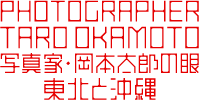芸術家・岡本太郎が撮影した写真が世に知られ始めるようになるのは、縄文土器との出会いを著した「日本の伝統」(1956年)からですが、本格的に写真を学んだのは1930年代のモンパルナスだったと言われています。当時パリ留学中だった岡本太郎はマン=レイやブラッサイといった有名な写真家たちとの交流やパリ大学の人類学者のマルセル=モースによるミュゼ・ド・ロム(人類博物館)での講義に影響されたことが後の写真表現につながっていきます。
戦後、帰国して再び芸術家としての活躍をはじめた岡本太郎は、「縄文の発見」や「対極主義」の実践を通して膨大な作品制作の傍ら近代日本の合理主義に納得しない人間の無垢な姿を見つめる旅へと向かいます。やがてその旅の記憶が軽妙かつ大胆な語り口とスピード感あふれる写真により生の東北を語るルポルタージュとして発表されます。それらは夜明けの列車の窓ごしに見た秋田の地からはじまる『日本再発見−芸術風土記』(新潮社1958年)、そして『神秘日本』(中央公論社1962年)として結実しました。またその間には、まだ復帰前の沖縄行を『沖縄文化論−忘れられた日本』(中央公論社1961年)にまとめ毎日文化賞受賞という高い評価にもつながりました。(66年再訪)。特に沖縄の海と島々への想いは強く、後に「ひとつの恋」のようなものだったと語っているように携行したカメラで切り取られた写真は苦く、切ない、いわば太郎からのちゅら海へあてた恋文とも言えるでしょう。
本展はこれらの記事の為に岡本太郎本人によって撮影された数百カットに及ぶフィルムの中から、写真評論家飯沢耕太郎氏によって厳選された写真約170点を展示します。50年前に「写真家」としての岡本太郎が東北と沖縄で捉えたイメージを彼自身の視点にたつことで私たちは岡本太郎その人を知ることになるのかも知れません。
The artist Okamoto Taro first took up photography in earnest during his years in Montparnasse in the 1930s. Aspects of Okamoto's later photographs reveal the varied influences of his experiences and the people he knew as a student in Paris at that time: his contacts with the famous photographers Man Ray and Bressai; the University of Paris anthropologist Marcel Mauss, whose lectures he attended at the Musee de l’Homme---these are but some examples.
After World War II following his return to Japan, Okamoto Taro began a new stage in his artistic career, through his attempts at the "discovery of the Jomon" and " Polarism," he produced enormous numbers of works and departed on his journey as a pure artist who would not accept the rationalism of modern Japan. Presently, the record of this journey came to fruition as his "Rediscovery of Japan: Topography of Art" and "Cryptic Japan." Also during this time, Okamoto captured images of Okinawa before the end of the U.S. occupation in "Essay on Okinawan Culture: A Forgotten Japan," a project for which he was awarded the prestigious Mainichi Culture Prize.
The present exhibition displays 170 photographs carefully selected by the photography critic Iizawa Kotaro from among the hundreds rolls of film shot by Okamoto himself. By looking through the eyes of Okamoto the photographer at images he shot of the Tohoku region and Okinawa fifty years ago, we can in the present learn more about this powerful individual.

